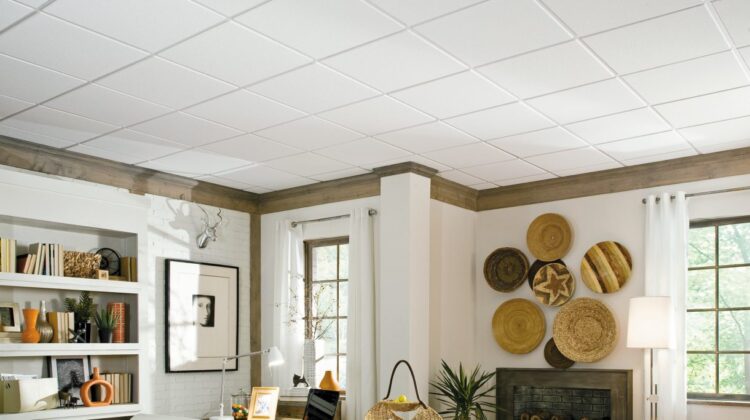
Do you need to improve the sound quality in your space? Are you looking for a solution that not only enhances acoustics but also boosts the aesthetics of your room? Acoustic ceilings are the answer to your needs. Acoustic ceilings are designed to absorb sound, reduce noise, and improve the overall sound quality in a room. In this article, we will discuss the benefits of acoustic ceilings, the different types of acoustic ceiling materials, how to choose the right acoustic ceiling installation and maintenance solution, and more. So, let’s dive into the world of acoustic ceilings and explore how they can enhance your space.
What is an Acoustic Ceiling?
An acoustic ceiling, also known as a suspended or drop ceiling, is a secondary ceiling installed below the main structural ceiling. Acoustic ceiling panels or tiles are made from sound-absorbing materials that help reduce noise and improve the overall sound quality within a room. These panels or tiles are typically suspended in a metal grid system, allowing easy access to the space above the ceiling for maintenance or adjustments.
Benefits of Acoustic Ceilings
There are several benefits to installing an acoustic ceiling in your space, including:
Improved sound quality: Acoustic ceilings absorb sound, reducing echo and reverberation, which results in clearer and more enjoyable audio experiences.
Noise reduction: Acoustic ceilings help to reduce the transmission of noise between rooms, making them ideal for offices, classrooms, and other spaces where privacy and quiet are important.
Aesthetic appeal: Acoustic ceiling panels and tiles come in a variety of styles, colors, and textures, allowing you to create a visually appealing space that complements your existing décor.
Easy installation and maintenance: Acoustic ceiling systems are designed for easy installation and maintenance, with removable panels or tiles that provide access to the area above the ceiling.
Energy efficiency: Acoustic ceilings can help to insulate your space, reducing energy costs by keeping your room warmer in the winter and cooler in the summer.
Fire resistance: Many acoustic ceiling materials are fire-resistant, providing an added level of safety for your space.
Types of Acoustic Ceiling Materials
There are several types of materials used in the construction of acoustic ceiling panels and tiles, including:
Mineral fiber: Mineral fiber is a popular choice for acoustic ceiling tiles due to its sound-absorbing properties and affordability.
Fiberglass: Fiberglass is a lightweight, durable material that provides excellent sound absorption. It is often used in combination with other materials, such as fabric or vinyl, to create a more aesthetically pleasing appearance.
Wood: Wood acoustic ceiling panels offer a warm, natural look while providing excellent sound absorption. They are available in various finishes and can be customized to match your existing décor.
Metal: Metal acoustic ceiling panels are durable and resistant to moisture and fire. They are available in various finishes and can be perforated to improve sound absorption.
Fabric: Fabric-wrapped acoustic ceiling panels provide a soft, attractive appearance while offering excellent sound absorption. They are available in various colors and patterns to match your décor.
Acoustic Ceiling Installation
Installing an acoustic ceiling requires careful planning and attention to detail. Here are some steps to follow during the installation process:
- Measure and plan: Begin by measuring your space and creating a layout for your acoustic ceiling grid. This will help determine the number of panels or tiles needed and ensure a proper fit.
- Install the grid system: Follow the manufacturer’s instructions to install the metal grid system, ensuring it is level and secure.
- Cut and place panels or tiles: Carefully cut your acoustic ceiling panels or tiles to size, if necessary, and place them into the grid system. Make sure to align any patterns or textures for a seamless appearance.
- Seal and finish: Apply any necessary sealants or finishes to your acoustic ceiling panels or tiles, following the manufacturer’s recommendations.
Acoustic Ceiling Maintenance
Maintaining your acoustic ceiling is essential to ensure its longevity and continued performance. Some maintenance tips include:
Regularly inspecting your acoustic ceiling for damage, such as cracks or sagging panels.
Cleaning your acoustic ceiling panels or tiles as needed, following the manufacturer’s recommendations for the specific material.
Replacing damaged or worn panels or tiles promptly to maintain the appearance and performance of your acoustic ceiling.
Ensuring proper ventilation in your space to prevent moisture buildup, which can lead to mold and mildew growth on your acoustic ceiling materials.
Choosing the Right Acoustic Ceiling Solution for Your Space
When selecting the best acoustic ceiling solution for your space, consider the following factors:
The purpose of your space: Consider the primary use of your room and the desired level of sound absorption and noise reduction.
Aesthetics: Choose a material and style that complements your existing décor and enhances the overall appearance of your space.
Budget: Determine your budget for both installation and maintenance and select a solution that fits your financial constraints.
Installation and maintenance requirements: Consider the ease of installation and maintenance for your chosen acoustic ceiling solution, ensuring it meets your needs and abilities.
Conclusion
Acoustic ceilings are an excellent way to improve the sound quality and aesthetics of your space. By understanding the benefits, materials, installation, and maintenance involved, you can make an informed decision about the best acoustic ceiling solution for your needs. Whether you are looking to create a quiet office environment, a comfortable home theatre, or an inviting classroom, an acoustic ceiling can help you achieve your goals and enhance your space.

